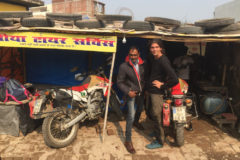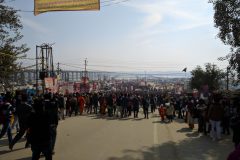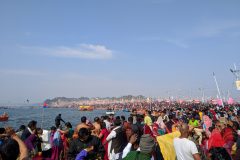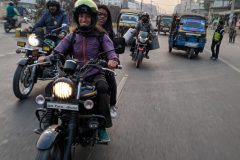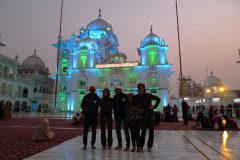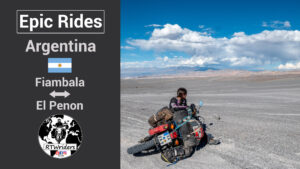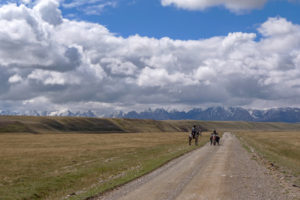When we return to Lucknow, we have been almost 2 months without our bikes and we are quite happy to have them back. Bablaa is so kind to pick us up at the airport, although it is already late. Compared to the south it really has become bloody cold in Lucknow.
We move to the same hotel, where we already stayed our first time in Lucknow. We asked Bablaa to organise some tyres for our bikes, while we were travelling to the south. Since tyre service is super cheap in India, Bablaa recommends to get the tyre exchange done at one of the street service shops nearby. When I see the tyre service station, I’m not really conviced yet. But hey – they are doing nothing else for the whole day, so let’s give it a try.
We bring them our bikes and the guys immediately start working on them, while we are having some chai tea. Tobi just turns around to watch them working, when he almost gets a heart attack. One of the “mechanic”-guys is about to jump on his giant wrench to loosen the front axle. He obviously doesn’t know, that you have to open the safety screws first, to be able to turn the axle. After the first shock is gone, Tobi devotes himself with some more tea. To take out the front wheel, they put the whole bike on 3 wobbly bricks. They don’t seem to notice, that the brake calliper probably would be destroyed, in case the bike falls off the dubious construction. So we rather stay close to be able to intervene in an emergency.
Tobi has put his tea away in the meanwhile to be able to follow the goings-on more closely. The following procedure is probably one of the most terrible wheel-“rapes” in the history of motorcycles. The nicely greased axle, the screw nuts and the bearing sealings are placed on the ground in the dust. Also the wheel with the half open bearings gets placed onto the ground, while one of the guys stands on top of it and tries to get the tyre bead to the middle of the rim by using a giant hammer, a chisel and a crowbar. Tobi is not sure, if he should cry, scream or intervene – but he also doesn’t want to be impolite. So he remains calm and hopes for the best grudgingly. “Guys, that’s an aluminium rim, not a 20€ steel rim from China and the bearings were flawless, before you touched them”, Tobi whimpers to himself. After a while he has finally managed to change the tyre and also the rim seems like it has survived the carnage passably. We are not wondering anymore, when they forget to tighten the safety screws after the wheel assembly.
The rear wheel isn’t luckier. They try to reassemble it completely off-centred and are not able to push in the axle anymore, of course. When they suddenly grab a hammer, Tobi finally has to stop them and rather does it person.
Miriam’s bike is treated a bit better in the end. But we can tell for sure, that we would never give our bikes to a repair shop in India without being able to observe the whole process. This masterpiece of craftsmanship will probably give me nightmares for a few months now. The only good thing is, that the wheels survived it and it cost almost nothing. We would never do it a second time though.
In the evening Bablaa shows us a restaurant, that is run by women, that are victims of acid attacks. He explains to us, that this is a problem all over India. In the beginning we are a bit uncomfortable, since we feel like stupid tourist gawkers. The women are very happy though to see some foreigners, so it was a nice experience in the end.
The day after we pack our bikes and are finally on the road again. Our destination is the sacred city Varanasi at the Ganges river, also known as the holy city of death. The road condition and the traffic is a total disaster. The manner how some Indians drive is very often not funny anymore, but grossly negligent and criminal. You could believe, that they really give a fuck to overrun somebody or to push a person in the ditch. We feel very tired, when we finally arrive in Varanasi and find a cosy hotel.
Varanasi is the holiest city in Hinduism and every Hindu wants to be interred at this place in the end. The city is full of small alleys and temples and never seems to sleep. At the Ganges river you find stairs everywhere. They offer an easy access for the people to purge themselves in the holy water. The most extraordinary places are the Ghats. These are the open cremation places and the big ones are in operation 24/7. Here – the dead are washed and laid out on funeral pyres. Finally they are burnt by the holy fire and their ashes are released into the Ganges river. Special guardians have been making sure for hundreds of years, that the holy fire doesn’t go out. The ceremonies are public and everybody can join. It is a very strange but special place and feels a bit like being transferred back to the middle age. Burning pyres everywhere and right in between sacred cows chilling out in the ashes or munching flowers, that are left from the ceremonies.
We stay to watch the ceremonies for a while and the longer we keep watching them, the more we are getting used to them. Actually it is quite nice and peaceful. One could think, that there is a terrible smell in the air, but it only smells like common fires – e.g. plastics/synthetics are also not allowed. Although the Ghats are sometimes very busy, it is always quiet. You can feel, that these places are repected and not taking any photos is also a part of it.
Right behind the Ghats all different goods for cremations are offered. Logs in various qualities, flowers, noble cloths and much more stuff. Then the hustle and bustle of the markets, the restaurants and the crazy busy traffic starts. Varanasi ist still a real Indian city and less “softened”/western, than most of the other tourist destinations in India. The people here are very friendly and less exhausting, compared to e.g. Rajasthan. In the evening we experience once again, how extraordinary the Indian biker scene is. Varanasi’s biker club was informed, that two foreign bikers are in town. So they contact us immediately and invite us to a delicious dinner without further ado.
Varanasi is extremely busy in this particular time. The reason for that is Kumbh Mela, the biggest festival in the world taking place in Allahabad. This event only happens every few years and lasts for ~7 weeks. 2019 it starts in Allahabad on the 15th january with the sacred bath Makar Sankranti. Millions of Hindus purge themselves in the Ganges river that day. The festival area in Allahabad comprises over 30 square kilometres. According to the internet more than 1,5 million people have already taken a bath till 2 p.m. that day. They expect around 150 million people to visit this event in 2019.
In the beginning we were not sure, if we should really go there. However the lovely father in law of our hotel owner in Lucknow said, that he would get a heart attack in case we would miss it out. We didn’t want to be responsible for that, of course. The accomodation prices in Allahabad during the festival are absolutely insane. Therefore we decided to stay in Varanasi and take our motorcycle to ride to Allahabad very early in the morning instead.
When we arrive in Allahabad we realise, that it was a good decision.. We have never seen so many people in one place and are not sure, if this is cool or we should rather run away. Parking areas are provided everywhere and security staff guides the crowd over the festival area very professionally. They accurately take care, that the people only move in one direction to prevent chaos.
We seem to be the only foreigners and we can’t remember anymore after a few minutes, how many selfies we have taken already that day. People are just everywhere. There are hundreds of stuffed boats on the river. Helicopters fly over the area to scatter flowers over the bathing crowd. The tent city is so big, that we can’t see the end, although we stand on one of the big bridges over the Ganges river. We are asked several times to take a bath, too. However the temperatures this day are way too low for us to have a dip. After every Indian visitor has probably taken a selfie with us and we could find our motorcycle again, we are happy to return to the much calmer Varanasi in the end.
We stay another two days in Varanasi, since Miri has given me her cold and it makes sense to cure it a bit, before we continue our journey. I am not surprised, that she infected me, since I would have been a medical miracle after all her coughing, wheezing and snoting.
In the meanwhile the bikers in Patna have contacted us and offered to organise an accomodation. So after we are feeling better again, we ride to Patna. It was on our way to India’s north-east anyway. We meet outside of the city centre at the train station and 5 bikers welcome us with flower neclaces. They bring us to a fanstatic hotel and a few of them even take time the next day to show us around in the city. So the next morning we hop on their bikes and we explore the old town, have plenty of chais, go for a walk along Ganges river and visit the phantastic Sikh temple Patna Saheb Gurdwara. Like the famous Taj Mahal, it is also built with white marble. As soon as it is dark the temple is illuminated with alternating colours. One of the bikers is Harsha Mishra, a young girl, that has recently travelled on her own through India with a bicycle. Now she is old enough to ride a motorcycle and she invites us to her home to meet her lovely family. She also wants to ride the world one day. They serve us some delicious goodies and it is a pleasure to meet her nice family. She even made a beautiful welcome poster, that must have taken her lots of time to make.
When we finally lie in our hotel beds, it suddenly rings on the door. Yes we have a doorbell for any reason. I check the time quickly – it is 2 a.m. and I just assume, that it must have been a mistake or a joke.
It continues ringing though and suddenly somebody even knocks on the door loudly. I trudge to the door drowsily, open it and face 6 heavily armed police men. They aren’t really speaking any English, but as far as I can understand, they are looking for alcohol. We don’t have any alcohol in the room, but they seem to take it quite seriously and don’t care about the time. My “faithful princess” (Miriam) gets roused briefly, when I turn on the light. However she just turns around, that the light is not shining in her face anymore. I probably can’t count with any support? So I end up standing there in my pyjamas (woolpower underclothing), while 6 pairs of eyes are inspecting our room, until I just tell them to enter and have a closer look at our luggage. This finally conviced them, that there is nothing to find and they leave again.
Our biker friends tell us the next day, that this is a common method for the local police to earn some extra “peanuts”. Alcohol is strictly forbidden in the state Bihar. Nobody tells you this fact and there are no noticeable signs either, but ignorance is no excuse.
The next morning we drive on to Purnia. The biker club riders have a surprise for us. They want to convoy us for a while and when we come out of the hotel, a dozen of bikers are already waiting for us. They even have already paid for our hotel – how cool is that! We ride together for around 2 hours and we have some lunch together, before we finally go our own way.
Purnia is not very touristic and it is already dark when we arrive there. Luckily our biker friends contacted a local biker in advance and he helps us to find a hotel. Otherwise it would have been a pain in the ass to find a hotel there. Purnia has no sights at all, so we immediately ride to Siliguri the next day.
To reach Siliguri you have to pass the narrow passage between Nepal and Bangladesh. Geographically it is situated in India’s north east, but it is still part of the state West Bengal. So it doesn’t count to the so called “Seven Sisters”-states, that are the real North-East India for many locals. However you can feel immediately, that this region already is a different India, compared to the rest of the subcontinent.

